5-out motion offense helps players read the defense
Our high school is small and our team lacks size. As a coaching staff, we felt that we needed to develop an offense that would help overcome this size differential and allow our players to do what they do best on the offensive side of the court. The solution to this problem was the implementation of a 5-out motion offense.
The 5-out motion offense causes havoc on those teams who like to pressure the ball and jam the cutters. By using this offense, players are able to spread the floor, read the defense and decide whether to curl cut or back cut.

With the constant movement of the players and fluid motion of the offense, defensive players soon become antsy, frustrated and begin to gamble on defense, which opens up numerous scoring opportunities.
Most opposing coaches eventually try to adjust to the 5-out motion and begin to sag their man-to-man defense. This strategy is fine with us because we’re a good 3-point shooting team, and the sagging defense opens up lots of good jump-shot opportunities.
After three years of having success running this offense, our team finally got a true post player with size and talent. Our coaching staff debated on whether we should stick with the 5-out motion offense or switch to a man-to-man orientated offensive system.
After a lot of thought, we decided that we could slightly modify the offense by adding a few easy adjustments. We were able to successfully include the post player into the offense without any major changes in the flow of the motion. In fact, the added wrinkles of a post option provided a new look to the offense, which further frustrated opposing defenses.
There are five reasons why the 5-out motion offense is effective for a team to use. A 5-out motion offense:
- Takes away help-side defense.
- Allows each offensive player an opportunity to score at any given moment.
- Teaches players how to play smart offensively and to read opposing defenses.
- Can be played against any defense, whether it’s a zone, man-to-man or any type of match-up zone defense.
- Utilizes basic skills, such as back cuts, head-and-shoulder fakes, pass fakes, etc.
Breakdown drills
Good passing is a key element for having success with a 5-out motion offense. Players must use good head-and-shoulder fakes (utilizing “pass-fake up, then passing down” technique) and wrap-around passes. The following two-player drills help players develop the passing techniques necessary for running this offense.
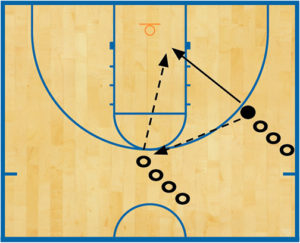 DIAGRAM 1: Two-player, pass-and-cut-to-the-basket drill (A). The player with the ball passes and cuts to the basket. The passer rebounds the layup and goes to the opposite line.
DIAGRAM 1: Two-player, pass-and-cut-to-the-basket drill (A). The player with the ball passes and cuts to the basket. The passer rebounds the layup and goes to the opposite line.
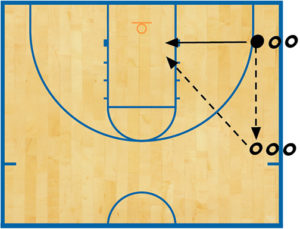 DIAGRAM 2: Two-player, pass-and-cut-to-the-basket drill (B).
DIAGRAM 2: Two-player, pass-and-cut-to-the-basket drill (B).
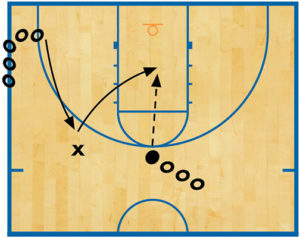 DIAGRAM 3: Two-player backcut drill (A). There are two key rules that players must remember when making backcuts. First, the player receiving the pass runs along the 3-point line, reads the defense and if the defense is overplaying he or she makes a sharp backcut. Second, players who are backcutting must setup the defense with a V-cut, plant the outside foot and cut hard to the basket.
DIAGRAM 3: Two-player backcut drill (A). There are two key rules that players must remember when making backcuts. First, the player receiving the pass runs along the 3-point line, reads the defense and if the defense is overplaying he or she makes a sharp backcut. Second, players who are backcutting must setup the defense with a V-cut, plant the outside foot and cut hard to the basket.
When the player is backcutting, he or she must cut to the ball side. If a cut is made to the weak side, it becomes hard for the passer to make the pass.
 DIAGRAM 4: Two-player backcut drill (B). When players are using backcuts on the baseline (see Diagrams 7 and 8), they must use a “power” move. This is due to the cutting player being positioned below the backboard.
DIAGRAM 4: Two-player backcut drill (B). When players are using backcuts on the baseline (see Diagrams 7 and 8), they must use a “power” move. This is due to the cutting player being positioned below the backboard.
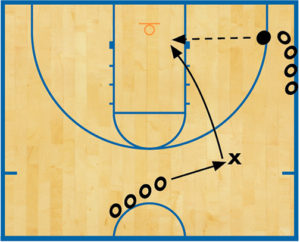 DIAGRAM 5: Two-player backcut drill (C).
DIAGRAM 5: Two-player backcut drill (C).
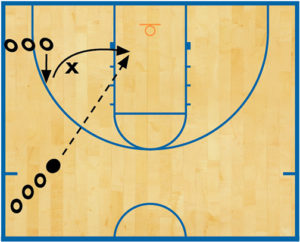 DIAGRAM 6: Two-player backcut drill (D).
DIAGRAM 6: Two-player backcut drill (D).
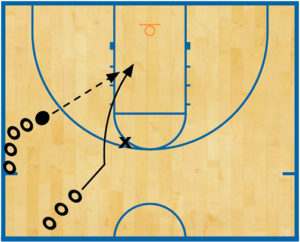 DIAGRAM 7: Two-player curl cut drill. When the defense starts to sag, the cutter must cut hard in front of the defense, setting the defender up by using a v-cut.
DIAGRAM 7: Two-player curl cut drill. When the defense starts to sag, the cutter must cut hard in front of the defense, setting the defender up by using a v-cut.
Baseline post-player options
When the post player has rotated to the baseline, he or she may post up in the mid-post area.
The main reason for posting up in the mid-post area is so the post player can either hand off to a cutter or use a rip move when the defense is overplaying the weak side. Once good post position has been established, the post player can use a solid post move and attack the basket.
 DIAGRAM 8: Post player moving to mid-post area.
DIAGRAM 8: Post player moving to mid-post area.
 DIAGRAM 9: Mid-post pass on weak-side overplay. When there’s an overplay from the weak-side defender, the mid-post player can make a rip move to the middle and pass to a cutter coming from the weak side.
DIAGRAM 9: Mid-post pass on weak-side overplay. When there’s an overplay from the weak-side defender, the mid-post player can make a rip move to the middle and pass to a cutter coming from the weak side.
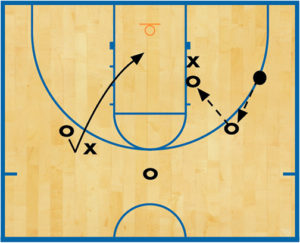 DIAGRAM 10: Mid-post three-player game. If the post player doesn’t get the ball, he or she can screen on the ball reversal or they can play a three-player game with the post.
DIAGRAM 10: Mid-post three-player game. If the post player doesn’t get the ball, he or she can screen on the ball reversal or they can play a three-player game with the post.
Baseline cuts on screens
 DIAGRAM 11: Baseline cuts on screens (A). The post player can screen out on the ball reversal. The player being screened has the option to cut to the baseline or middle.
DIAGRAM 11: Baseline cuts on screens (A). The post player can screen out on the ball reversal. The player being screened has the option to cut to the baseline or middle.
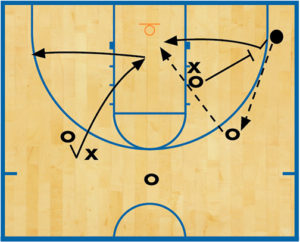 DIAGRAM 12: Baseline cuts on screens (B). The player on the weak side clears out when he or she sees the screen. This option also clears out the help defense.
DIAGRAM 12: Baseline cuts on screens (B). The player on the weak side clears out when he or she sees the screen. This option also clears out the help defense.
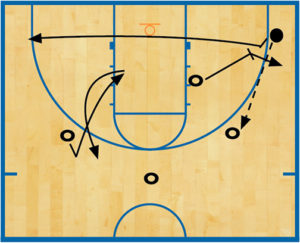 DIAGRAM 13: Baseline cuts on screens (C). The post player pops out after the screen while the player being screened clears out, and the weak-side player moves back up the 3-point line.
DIAGRAM 13: Baseline cuts on screens (C). The post player pops out after the screen while the player being screened clears out, and the weak-side player moves back up the 3-point line.
 DIAGRAM 14: Dribble entry (with pass). If the point guard can’t start the offense with a pass to the wing, he or she must use a dribble entry. The point guard reads the defense and if the defense is denying hard, he or she dribbles at the wing player. This lets the wing player know that he or she needs to backcut and move to the weak side or receive a pass.
DIAGRAM 14: Dribble entry (with pass). If the point guard can’t start the offense with a pass to the wing, he or she must use a dribble entry. The point guard reads the defense and if the defense is denying hard, he or she dribbles at the wing player. This lets the wing player know that he or she needs to backcut and move to the weak side or receive a pass.
 DIAGRAM 15: Dribble entry with clear out. Any time a player has problems making the pass, they can dribble toward a teammate, which tells the offensive player to backcut.
DIAGRAM 15: Dribble entry with clear out. Any time a player has problems making the pass, they can dribble toward a teammate, which tells the offensive player to backcut.
Basic 5-out offense
For this offense, spacing is very important. Players must be lined up one or two feet above the 3-point line and 10 to 15 feet apart.
There must be constant movement. If a player doesn’t get the ball, he or she must cut (using a backcut or curl cut). When the defense starts to sag, players must shoot or drive to the basket. As soon as a player receives the ball, he or she must turn and face the basket to see the cutters.
If a player passes down, he or she then cuts to the weak side. If a player passes up, he or she must fill to the ball side.
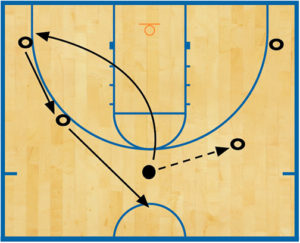 DIAGRAM 16: 5-out motion offense (A).
DIAGRAM 16: 5-out motion offense (A).
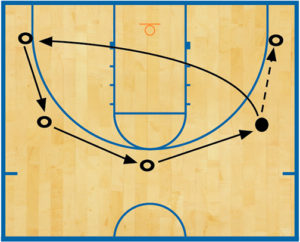 DIAGRAM 17: 5-out motion offense (B).
DIAGRAM 17: 5-out motion offense (B).
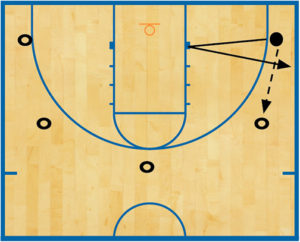 DIAGRAM 18: 5-out motion offense (C). Pass up, cut to the basket and refill action.
DIAGRAM 18: 5-out motion offense (C). Pass up, cut to the basket and refill action.
 DIAGRAM 19: 5-out motion offense (D). Pass to the top of the key. The passer cuts and fills to the baseline while the baseline player moves up to the wing area.
DIAGRAM 19: 5-out motion offense (D). Pass to the top of the key. The passer cuts and fills to the baseline while the baseline player moves up to the wing area.









